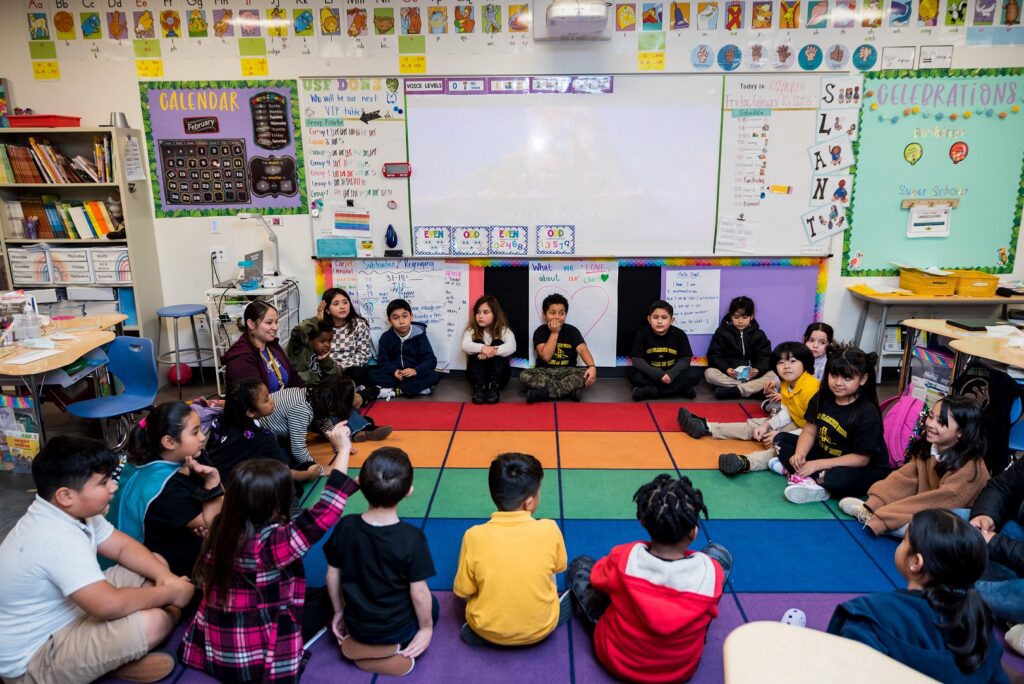
Courtesy: Aspire Public Schools
Plenty of conversations in California have focused on recruiting teachers into the profession as a way to grapple with the state’s teacher shortage. This is important, and as a transitional kindergarten teacher, I am acutely aware of how quality teachers can impact our students and communities.
I pursued teaching largely because I want to be the representation I didn’t see growing up. I participated in a teacher residency program that built my confidence in the classroom and taught me to connect with my students by highlighting my own identity. It’s not only the way I was recruited to the profession, it’s also played a role in my retention.
To continue to tackle the teacher shortage, I believe California needs more strong teacher residency programs. Nearly 37% of U.S. public schools experienced at least one teacher vacancy, contributing to nearly half of public school students entering the 2023-24 school year behind grade level in at least one subject. Amid these shortages, California is still reeling from the repercussions of surpassing 10,000 vacancies during the 2021-22 school year. The effects are felt even more so in under-resourced, Latino or Black communities.
At Aspire Richmond Technology Academy, where I teach, I can see how we must prepare educators and then provide the tools for teachers to sustain themselves. It’s how we can prevent shortages and retain teachers down the road.
It was a winding road for me to realize that teaching was my calling. I never envisioned myself becoming an educator, largely because I rarely saw teachers who looked like me or who connected with me on a cultural level. While studies point to the importance of a demographic match between teachers and students, I experienced a real lack of Asian representation in education.
This changed when I went to college. With more exposure to Asian professors, I finally felt seen and represented. I felt empowered that education was a field I could pursue. And I put the puzzle pieces together — that all of my volunteer work and extracurricular activities centered around helping students. By the time I switched majors, I had some catching up to do.
When I learned about teacher residency programs in California, I jumped at the opportunity. I received a master’s degree and a California teaching credential in a single year. Even in my first year of teaching, I felt more prepared than other teacher friends.
While we can’t solve the teacher shortage overnight, here’s how we can ensure we’re training more young people to become highly effective educators and stay in the profession.
First, we need an intensive teacher residency program that builds confidence. Through Aspire’s teacher residency program at Alder Graduate School of Education, I apprenticed four days a week and had a personal mentor in the classroom with me who provided me with critical one-on-one support. Toward the end of my time as an apprentice, one of the students in our classroom asked my mentor, “So, what’s your job?” This gave me the confidence to teach the following year on my own. I learn best through a hands-on approach, so four days a week in the classroom with one day for intensive seminars and subject-matter courses helped me gain more real life experience.
Second, this wouldn’t be possible without strategic financial supports. We know that systemic inequities, including the high cost of college, hold too many back from pursuing a career in education. Ensuring teacher residents receive a stipend while earning their degree and credential(s) can help. Through a partnership, the program I participated in is helping to support staff members in earning and paying for an undergraduate degree with teaching credentials. Given the importance of representation in the classroom, the partnership prioritizes aspiring teachers of color and those from the local communities.
Finally, we should expand teacher residency programs that are accessible for individuals of all backgrounds. While California has made big investments in teacher residency programs, we also need to focus on effective teacher training initiatives that reflect our school’s communities. When I participated, my teacher residency program focused on “head, heart and hands.” This meant that we integrated theory and research (head), with a culturally responsive equity lens (heart), and our coursework mirrored our field work (hands). Highlighting representation, multiculturalism and identity continues to be stressed throughout the program — and it’s something I hold dear to my heart.
Last week, I proudly watched a kindergarten promotion, which included many of my previous TK students from my student teaching year. Seeing their growth academically, and how much confidence they have gained in themselves and their identities, is another reason why I continue to pursue education. In many ways, their growth reflects my own. And knowing that I contributed a small part to my former and current scholars’ successes, as they flourish in their own ways, brings me a surge of pride.
The programs at Aspire are happening at scale, with more than 36 schools serving more than 15,400 students across California. Not only did my residency program get me into the classroom, it’s played a role in keeping me there. We need more effective residency programs, and this can serve as a model for retaining teachers in California.
•••
Annika Emmanuelle Mendoza teaches transitional kindergarten at Aspire Richmond Technology Academy in Richmond.
The opinions expressed in this commentary represent those of the author. EdSource welcomes commentaries representing diverse points of view. If you would like to submit a commentary, please review our guidelines and contact us.

